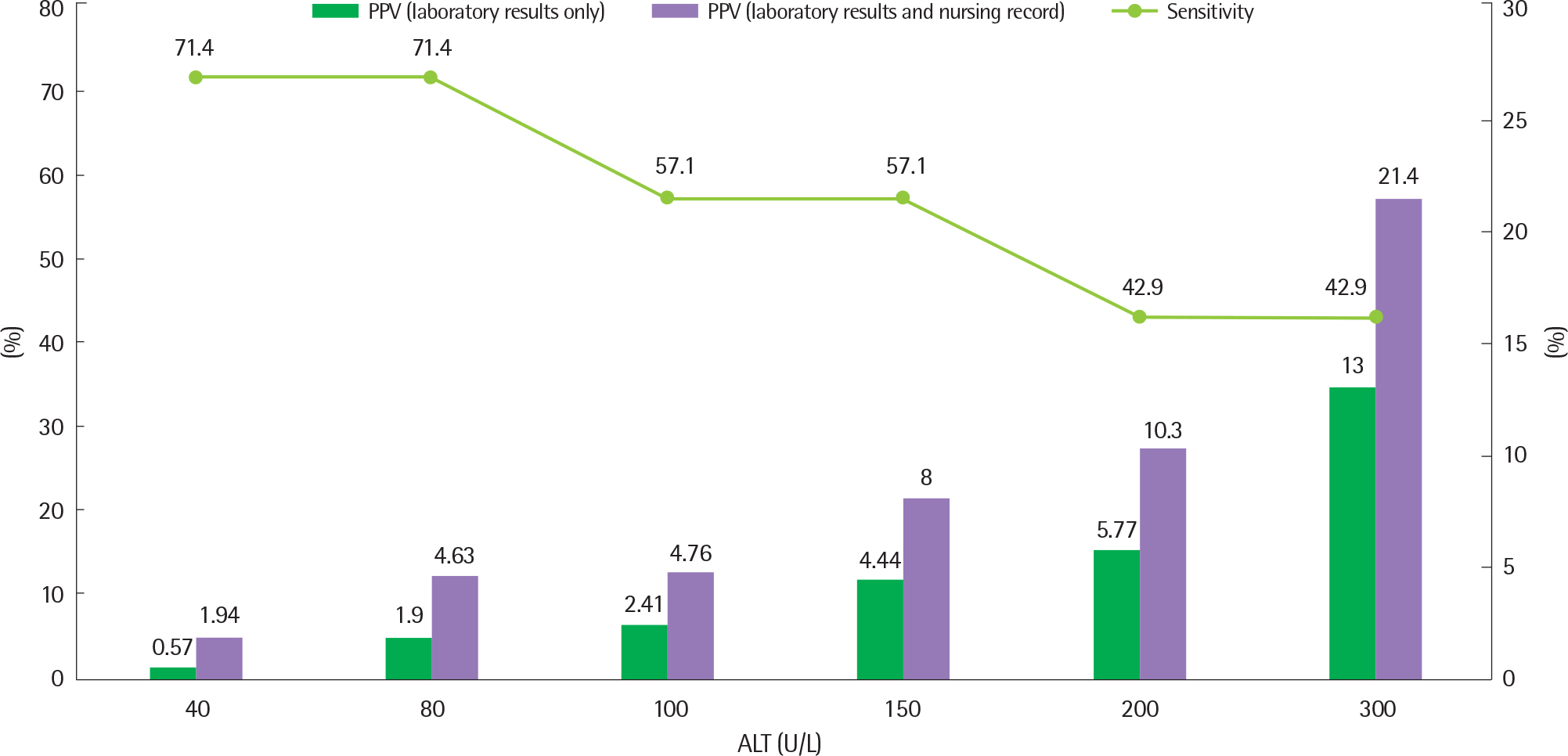Allergy Asthma Respir Dis.
2018 May;6(3):149-154. 10.4168/aard.2018.6.3.149.
Optimal methods to detect DRESS (drug reaction with eosinophilia and systemic symptoms) syndrome by electronic medical records
- Affiliations
-
- 1Drug Safety Monitoring Center, Seoul National University Hospital, Seoul, Korea. helenmed@snu.ac.kr
- 2Seoul National University College of Medicine, Seoul, Korea.
- 3Public Health Medical Service, Seoul National University Hospital, Seoul, Korea.
- 4Department of Internal Medicine, Seoul National University Hospital, Seoul, Korea.
- 5Department of Internal Medicine, Gyeongsang National University Hospital, Jinju, Korea.
- KMID: 2412517
- DOI: http://doi.org/10.4168/aard.2018.6.3.149
Abstract
- PURPOSE
Since drug reaction with eosinophilia and systemic symptom (DRESS) syndrome is very rare and difficult to diagnose, its exact epidemiology is still unknown. If screening tools based on laboratory results or electronic medical records are available, the occurrence of DRESS syndrome can be monitored in real time.
METHODS
To screen cases with DRESS syndrome, all the results of both eosinophil and alanine transaminase (ALT) level from July 2014 to June 2015 were analyzed by 36 searching conditions for the signal detection of 7 definite DRESS cases among 199,924 patients during the study period. Those searching conditions were diverse combinations of different cutoff levels of eosinophil and ALT with or without nursing records presenting skin symptoms. Sensitivity, specificity, positive predictive value (PPV) and negative predictive value were calculated for individual searching conditions.
RESULTS
As cutoff levels of eosinophil and ALT for screening DRESS increased from 3% to 5% and 40 U/L to 300 U/L, respectively, the sensitivity decreased from 100% to 42.9% and the PPV increased from 0.06% to 13.0%. A combination of eosinophil >10% and ALT >300 U/L which had the highest PPV among 36 search conditions could detect DRESS syndrome by sensitivity 42.9% and PPV 13.0%. When nursing records for skin symptoms were added, PPV was augmented to 21.4%.
CONCLUSION
A combination of eosinophil and ALT levels is a useful search condition for the screening of DRESS syndrome. Nursing records can provide an additional increment in PPV.
Keyword
MeSH Terms
Figure
Cited by 1 articles
-
Screening of severe adverse drug reaction by electronic medical record search
Cheol-Woo Kim
Allergy Asthma Respir Dis. 2018;6(3):135-136. doi: 10.4168/aard.2018.6.3.135.
Reference
-
1. Pichler WJ, Adam J, Daubner B, Gentinetta T, Keller M, Yerly D. Drug hypersensitivity reactions: pathomechanism and clinical symptoms. Med Clin North Am. 2010; 94:645–64.
Article2. Fiszenson-Albala F, Auzerie V, Mahe E, Farinotti R, Durand-Stocco C, Crickx B, et al. A 6-month prospective survey of cutaneous drug reactions in a hospital setting. Br J Dermatol. 2003; 149:1018–22.
Article3. Chiou CC, Yang LC, Hung SI, Chang YC, Kuo TT, Ho HC, et al. Clinico-pathological features and prognosis of drug rash with eosinophilia and systemic symptoms: a study of 30 cases in Taiwan. J Eur Acad Dermatol Venereol. 2008; 22:1044–9.4. Eshki M, Allanore L, Musette P, Milpied B, Grange A, Guillaume JC, et al. Twelve-year analysis of severe cases of drug reaction with eosinophilia and systemic symptoms: a cause of unpredictable multiorgan failure. Arch Dermatol. 2009; 145:67–72.
Article5. Husain Z, Reddy BY, Schwartz RA. DRESS syndrome: part II. Management and therapeutics. J Am Acad Dermatol. 2013; 68:709.e1–9.6. Chaiken BH, Goldberg BI, Segal JP. Dilantin sensitivity; report of a case of hepatitis with jaundice, pyrexia and exfoliative dermatitis. N Engl J Med. 1950; 242:897–8.7. Choudhary S, McLeod M, Torchia D, Romanelli P. Drug reaction with eosinophilia and systemic symptoms (DRESS) syndrome. J Clin Aesthet Dermatol. 2013; 6:31–7.8. Cacoub P, Musette P, Descamps V, Meyer O, Speirs C, Finzi L, et al. The DRESS syndrome: a literature review. Am J Med. 2011; 124:588–97.
Article9. Bocquet H, Bagot M, Roujeau JC. Drug-induced pseudolymphoma and drug hypersensitivity syndrome (Drug Rash with Eosinophilia and Systemic Symptoms: DRESS). Semin Cutan Med Surg. 1996; 15:250–7.
Article10. Kardaun SH, Sidoroff A, Valeyrie-Allanore L, Halevy S, Davidovici BB, Mockenhaupt M, et al. Variability in the clinical pattern of cutaneous side- effects of drugs with systemic symptoms: does a DRESS syndrome really exist? Br J Dermatol. 2007; 156:609–11.11. Shiohara T, Iijima M, Ikezawa Z, Hashimoto K. The diagnosis of a DRESS syndrome has been sufficiently established on the basis of typical clinical features and viral reactivations. Br J Dermatol. 2007; 156:1083–4.
Article12. Choi HG, Byun J, Moon CH, Yoon JH, Yang KY, Park SC, et al. Allopuri-nol-induced DRESS syndrome mimicking biliary obstruction. Clin Mol Hepatol. 2014; 20:71–5.
Article13. Iacob SA, Sotropa A. DRESS syndrome with hepatic involvement in a patient with depressive disorder. Rom J Intern Med. 2014; 52:163–6.14. Droz N, Thiebaut M, Terrier B, Bérézné A, Sogni P, Beuvon F, et al. Severe cholestatic hepatitis revealing a DRESS syndrome. Rev Med Interne. 2013; 34:645–8.15. Yang MS, Kang MG, Jung JW, Song WJ, Kang HR, Cho SH, et al. Clinical features and prognostic factors in severe cutaneous drug reactions. Int Arch Allergy Immunol. 2013; 162:346–54.
Article16. Husain Z, Reddy BY, Schwartz RA. DRESS syndrome: part I. Clinical perspectives. J Am Acad Dermatol. 2013; 68:693.e1–14.17. Kano Y, Inaoka M, Shiohara T. Association between anticonvulsant hypersensitivity syndrome and human herpesvirus 6 reactivation and hy-pogammaglobulinemia. Arch Dermatol. 2004; 140:183–8.
Article18. Shiohara T, Kano Y. A complex interaction between drug allergy and viral infection. Clin Rev Allergy Immunol. 2007; 33:124–33.
Article19. Criado PR, Criado RF, Avancini JM, Santi CG. Drug reaction with Eosinophilia and Systemic Symptoms (DRESS)/Drug-induced Hypersensitivity Syndrome (DIHS): a review of current concepts. An Bras Dermatol. 2012; 87:435–49.
- Full Text Links
- Actions
-
Cited
- CITED
-
- Close
- Share
- Similar articles
-
- Drug Reaction with Eosinophilia and Systemic Symptom Syndrome Due to Everolimus: A Case Report
- Diagnosis and Management of DRESS (Drug Reaction with Eosinophilia and Systemic Symptoms) Syndrome
- A Case of Sitagliptin Induced DRESS Syndrome
- DRESS (drug reaction with eosinophilia and systemic symptoms) syndrome induced by lamotrigine in a child
- Drug Reaction with Eosinophilia and Systemic Symptoms (DRESS) Syndrome Induced by Ethambutol and Rifampin


